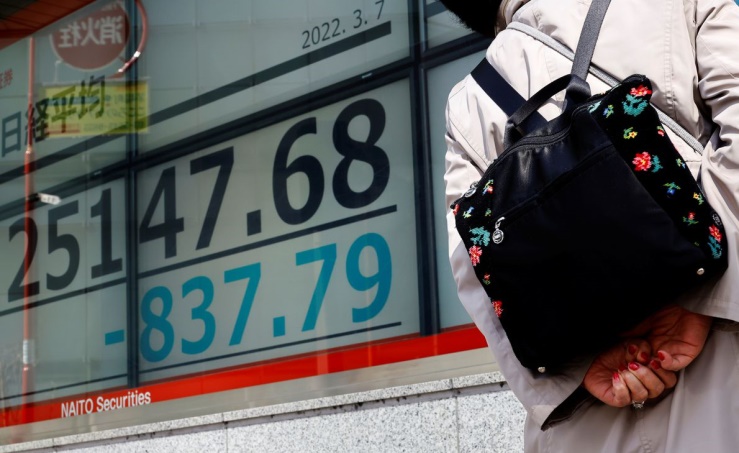
Asian shares fell to their lowest in nearly two years on Tuesday, as investors fretted about the toxic cocktail of rising interest rates and lower economic growth.
Growing fears of recession and a slowdown in China dragged down commodity-linked currencies and oil prices, though safety flows kept the dollar near 20-year highs, Reuters reports.
MSCI’s broadest index of Asia-Pacific shares ex-Japan tumbled as much as 2.3% to 515.7, sliding for a seventh straight session and extending losses to 18% so far this year. The benchmark later pared losses to trade down 1.3%.
Across Asia, share indexes were a sea of red but traded above the day’s lows in volatile markets. The Nikkei lost 0.9%, Australian shares shed 1.3%, Korean stocks lost 1.2% and Taiwan equities were down 0.3%.
“Chinese growth is facing significant headwinds, whether you look at official or private sector Purchasing Managers’ Index,” said Song Seng Wun, an economist at CIMB Private Banking.
“Softening global growth is the persistent wall of worry for markets as investors look beyond the next 3-6 months. The view on growth momentum seems to be that revenge spending after the pandemic may be affected by higher borrowing costs,” he said.
MSCI’s Asian benchmark fell to the lowest since early July 2020. Chinese equities are the worst performers among major markets so far this year, recording losses of between 21 and 25%. Singapore and Indonesian stock indexes have, however, ticked up.
Growth worries resurfaced after central banks in the United States, Britain and Australia raised interest rates last week and investors girded for more tightening as policymakers fight soaring inflation.
Hong Kong’s benchmark share index returned from a one-day holiday sharply lower on Tuesday and slumped more than 4% before nearly halving losses.
On Monday, Shanghai and Beijing tightened COVID-19 curbs which have already taken a heavy toll on the world’s second-largest economy.
China’s export growth slowed to its weakest in almost two years, data showed, as the central bank pledged to step up support for the slowing economy.
U.S. stock futures turned positive after declining earlier. S&P 500 stock futures rose 0.4%, Dow Jones futures ticked up 0.3% and Nasdaq futures gained 0.7%.
Overnight, U.S. stocks extended Friday’s bruising sell-off as investors rushed to protect themselves against the prospect of a weakening economy.
“The idea of a benign and gentle tightening cycle has evaporated,” ANZ analysts said in a report.
“The reality is that the Fed cannot control the supply side of the economy in the short-run, so as long as key indicators like the labour force participation rate stay low and Chinese exports slow, the risk to inflation, and therefore interest rates, lies to the upside,” ANZ said.
Oil prices ticked lower on demand worries as coronavirus lockdowns in China, the top oil importer, continued.
Brent crude fell 1% to $104.75 a barrel and U.S. West Texas Intermediate crude also declined 1.1% to $101.96 a barrel, adding to a 6% slump in the previous session. Both contracts are still up about 35% so far this year.
Commodity-linked currencies including the Australian and Canadian currencies took a beating as oil prices fell.
The Australian dollar dropped as low as $0.6920, its weakest since July 2020, having fallen 1.7% overnight. Lower oil prices also hit the Canadian dollar, which eased to C$1.3037 per dollar, its weakest since November 2020.
The dollar index was steady at 103.6, having risen as high as 104.19 overnight, a fresh 20-year peak.
U.S. Treasury yields, which have climbed sharply on expectations of aggressive tightening by the Federal Reserve, took a breather after Atlanta Fed President Raphael Bostic pushed back on suggestions of a massive 75 basis point rate hike at the Fed’s next meeting.












